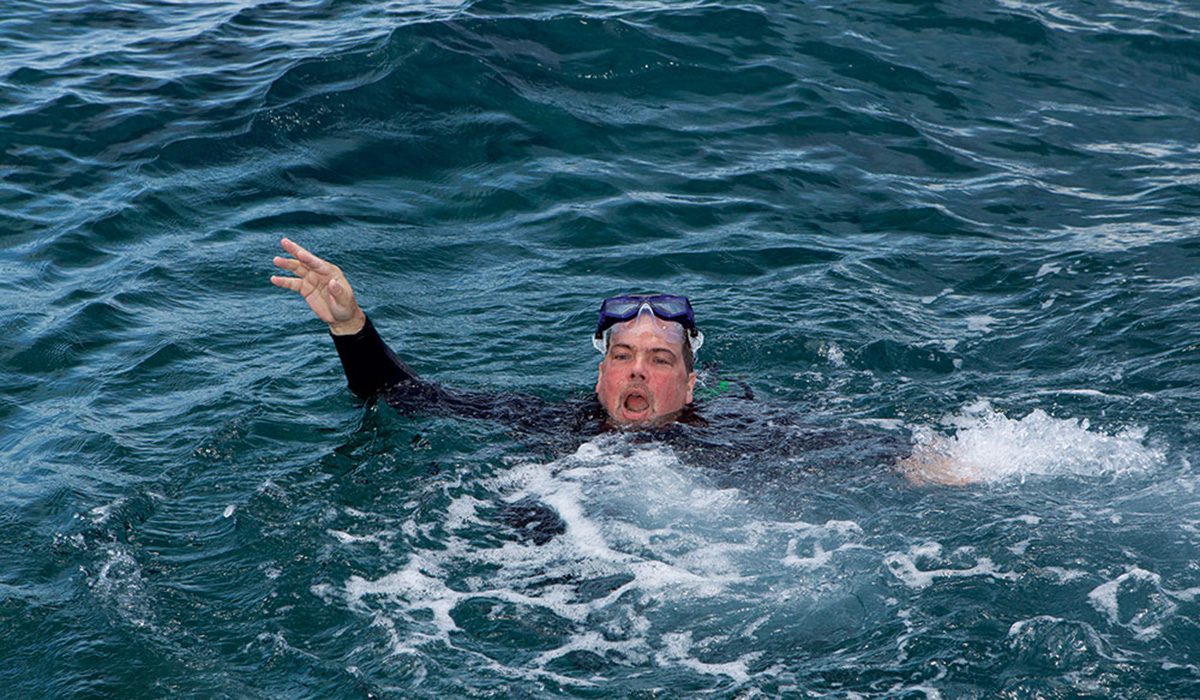I found another one before reading your post, because I wasn't sure what it would really look like. You can see what's going on a little better in this video. In this one, the kid looks to me like he's swimming around just fine. By the time you realize he isn't, you can't see him at all. The kid didn't make it, despite being about 1 foot from a friend.
All the kid needed to do was extend a leg to help this boy. What a tragedy!
I've noticed in some of these stories about divers almost drowning, not inflating their BCDs, sinking, etc., is that they were wearing SCUBA, but did not grab their mouthpiece and start breathing off the SCUBA. It's as if they forgot they had a source of breathing air while underwater.
I've had several encounters over the years. I'll discuss these, and then post a video I took this summer of a "situation" that could have gone badly, in my estimation.
Swimmers "Tubing"
In the 1960s I took some kids fishing while I was in high school to the Little North Fork of the North Santiam River. We were above a series of rapids. Earlier, we had been in a pool below this rapids when a guy popped up in the pool. These rapids were about 200 yards long, and ended with much of the river going under a large (60 to 80 foot high) rock. This guy was wearing a life jacket, and we assisted him out of the water. He had been pulled under the rock, battered around a bit on rocks, and surfaced in the pool.
About half an hour after that we were above the main rapids when we saw an inner tube come right by us as we were fishing. On the inner tube were a girl about 10 years old, and two younger children (boys, as I remember). As they swung by us, the girl said in a soft voice, "Help us." I jumped in and John McKeon also jumped in to pull the tube with these kids out of the water. They were headed down the same rapids that the guy had just recently gone through, but none of them had life jackets on.
Clackamas River Swimmer
I regularly dive the same section of the Clackamas River near Gladstone. About ten years ago, I was ending my dive, which was a float from High Rocks to Cross Park, and starting to get out of the water. I looked across the river and noticed a swimmer who was "swimming" and bobbing in the water. He was alternatively taking a few strokes, and then going underwater, and taking a few more. I decided to swim over to him and see what was happening. He was not going fast at all, so I caught up pretty easily with him. I stayed beside him, and though we were next to each other, couldn't talk much because he spoke Spanish and I spoke English.
Anyway, he made it to the far shore, and then had to swim back to his party on the north shore. Again, he was alternatively swimming and bobbing, and I noted that he would push off the bottom (the water was about 9 feet, or two meters, deep. Then he started getting really tired, and near the north shore was a much faster current. As he "swam" he got disoriented, and started inadvertently headed directly down current, toward some mild rapids and much deeper water. I was in my fins and snorkeling with my SCUBA unit, and so I turned him around so that he was again headed into the current and a bit toward the north shore (crabbing). He made the north shore a few minutes later, and he and I both exited.
I was getting out when a Gladstone police officer met me and I told him what was happening. Then his radio went off, and he said, "I have to take this." He then said into the radio, "He's right here, and I'm talking to him." This officer was there to check on me, since the High Rocks lifeguards had inquired because I was overdue from the time I told them I would be back to tell them I was okay. It was heartening to know that they had contacted the officer when I hadn't come back on time from me solo dive.
In-water Lifejacket Problem
I'll be posting a video here of a gal who ran into problems with a lifejacket someone had thrown to her, that she could not get into. This video is one that I inadvertently filmed as my helmet camera remained on after my dive. I noted that she was having problems, but no one was attending to her even though she was within feet of her swim mates. I have to upload it to YouTube, but it will be here within a day or so. Looking at this thread, I think she may have been in more difficulty than I had realized at the time.
This video was filmed last June, 2021. The water temperature was about 68 degrees F, depth of the hole was 22 feet (about 7 meters) deep, and this video shows the difficulty of putting on a lifejacket in the water. But this also shows some of the same markers that were talked about on this thread for recognizing a drowning victim. The gal on the paddleboard was a lifeguard assigned to this section of the river.
At the time, I felt it was not a life threatening emergency, but that she was having difficulty. My motto from my U.S. Air Force days is "
These Things We Do, That Others May Live." I also say that "Nobody drowns in my section of the river while I'm there."
SeaRat




